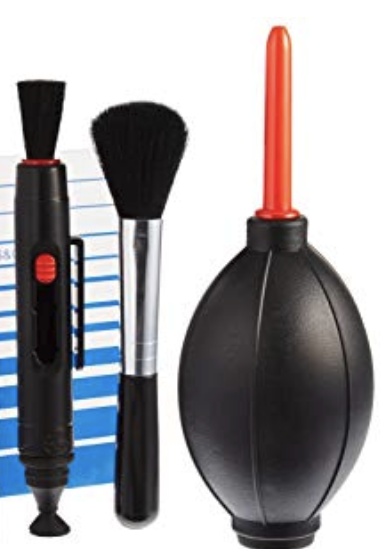Camera and Lens Care
August 5, 2019 by Marie Joabar
Keeping your camera and lens clean goes a long way in preventing equipment damage and also helps save money to have it sent in for cleaning.
Before Shooting
Look at your front lens element and see if it needs cleaning. Finger smudges, dust, and other debris on your lens may appear in your images, especially when using f16 and 22 when there is sharpness front to back.
After Shooting
 Make it a habit to wipe down your gear before stowing in your camera bag. This keeps the dust from getting inside the bag and working its way back onto your equipment. Use a larger lens cloth to wipe it down. It’s good practice to extend your zoom lens and wipe the exterior barrel down as well so dirt won’t work its way into the lens.
Make it a habit to wipe down your gear before stowing in your camera bag. This keeps the dust from getting inside the bag and working its way back onto your equipment. Use a larger lens cloth to wipe it down. It’s good practice to extend your zoom lens and wipe the exterior barrel down as well so dirt won’t work its way into the lens.
Sand and grit can be extremely damaging to our gear. Keep an old tooth brush around to brush the crevices of your lenses and the exterior of your camera body occasionally. When wiping down the part of the camera body that meets the lens, or vice versa, turn it upside down (with the opening toward the floor) so any dust falls out of the camera or lens.
Lens Cleaning Tips
To clean the front glass use a lens cloth and wipe the glass. Also try using a “lens pen.” This has a brush on one end which can be used to brush off dust on the glass or other areas on the lens or camera. On the other end of the lens pen is an eraser type fabric which is great if you have a stubborn spot on the glass. With stubborn smudges, you could also try breathing on the glass to create a bit of condensation and then wiping it down.
Protect The Front Lens Element
 Lens hoods and UV Filters are especially helpful for protecting lenses. Hoods keep stray light from entering the lens but also protect it from rain or snow or from getting scratched. The clear UV filter protects the lens from getting scratched but many times it helps absorb the damage if the camera or lens is dropped. Note – when using filters, don’t stack them, take off one filter if you’re going to use a different one such as a circular polarizer.
Lens hoods and UV Filters are especially helpful for protecting lenses. Hoods keep stray light from entering the lens but also protect it from rain or snow or from getting scratched. The clear UV filter protects the lens from getting scratched but many times it helps absorb the damage if the camera or lens is dropped. Note – when using filters, don’t stack them, take off one filter if you’re going to use a different one such as a circular polarizer.
Cleaning Camera Sensors
When you view images on your computer, if you’ve noticed spots in the same place then you’re looking at sensor dust, tiny specs of dust or dirt that are on your sensor. You can try blowing it off the sensor with a rubber squeeze bulb. If that doesn’t do the trick, a more involved cleaning may be needed. You can try it yourself or send it off to a trained specialist. Your local camera store might also offer this service. This link takes you to an article about the ins and outs of sensor cleaning, The Skinny On Sensor Dust.
Weather and Temperature
 Condensation forms on both the outside as well as the inside of your camera and lens when we move from the cold to the warm. This can damage our gear so allow time for the gear to acclimate by leaving it inside your camera bag. In the summer when going from cold air conditioning to a humid outdoors, place your camera bag outdoors for about 30 minutes before pulling it out to start shooting. In the winter, bring it indoors inside your camear bag and leave it to acclimate to the warmer conditions for about 30 minutes.
Condensation forms on both the outside as well as the inside of your camera and lens when we move from the cold to the warm. This can damage our gear so allow time for the gear to acclimate by leaving it inside your camera bag. In the summer when going from cold air conditioning to a humid outdoors, place your camera bag outdoors for about 30 minutes before pulling it out to start shooting. In the winter, bring it indoors inside your camear bag and leave it to acclimate to the warmer conditions for about 30 minutes.
Plastic rain sleeves are handy to have in your bag in the event of unexpected rain or snow. These are made to cover both the camera and the lens while you are photographing. No need for a little bit of rain to spoil your shooting. They can be found at many price points from $6 for a quick plastic cover to $200 or more for a more professional cover made of sturdier fabric.
After investing hundreds of dollars on your gear, good habits for protecting and cleaning it will save you time, money and frustration.
